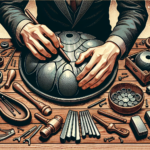<!DOCTYPE html>
<html lang="en">
<head>
<meta charset="UTF-8">
<meta name="viewport" content="width=device-width, initial-scale=1.0">
<title>Handpan Mallets: A Comprehensive Guide for Beginners</title>
<style>
body {
font-family: Arial, sans-serif;
line-height: 1.6;
margin: 20px;
}
h1, h2, h3 {
color: #333;
}
p {
color: #555;
}
ul {
margin-left: 20px;
}
</style>
</head>
<body>
<h1>Handpan Mallets: A Comprehensive Guide for Beginners</h1>
<p>The mesmerizing and ethereal sound of the handpan has captivated many music enthusiasts worldwide. Known for its soothing tones and intuitive playing style, the handpan is a unique instrument that encourages exploration and creativity. While traditionally played with the hands, many players are discovering the benefits of using mallets to explore new sonic territories. This comprehensive guide aims to shed light on handpan mallets, offering beginners insights into selecting, using, and maximizing the potential of these tools to enhance their musical journey.</p>
<h2>Understanding Handpan Mallets</h2>
<p>Handpan mallets are specially designed sticks that feature a soft, padded end used for striking the handpan. These mallets can offer new textures and dynamics to your music, allowing for a different expression that might not be achievable with hands alone. Whether you're looking to create rich, sustained notes or soft, subtle taps, the right pair of mallets can be a significant addition to your playing style.</p>
<h2>Types of Handpan Mallets</h2>
<p>There are various types of handpan mallets, each offering unique characteristics:</p>
<ul>
<li><strong>Rubber Tip Mallets:</strong> These mallets have rubber tips that provide a crisp attack and are often used for a clearer, more articulated sound.</li>
<li><strong>Felt Tip Mallets:</strong> Offering a softer sound, felt tips are ideal for gentle playing styles, where a warm tone is preferred.</li>
<li><strong>Wooden Mallets:</strong> These are less common but can be used for specific effects, offering a very defined and pronounced sound.</li>
<li><strong>Silicone Mallets:</strong> Known for their versatility, silicone tips provide a range of dynamics suitable for various playing techniques.</li>
</ul>
<h2>Choosing the Right Mallets</h2>
<p>The choice of mallets greatly influences the sound you produce. Here are some factors to consider when selecting handpan mallets:</p>
<h3>Material</h3>
<p>The material of the mallet's tip is crucial in determining the quality of sound. Softer materials such as felt create warmer, softer tones, while harder materials like rubber offer more brightness and definition.</p>
<h3>Weight</h3>
<p>Lightweight mallets are typically easier to handle for beginners, providing greater control over dynamics. Heavier mallets can offer richer, deeper tones but can be more challenging to manage.</p>
<h3>Length</h3>
<p>The length of the mallet affects leverage and control. Longer mallets offer a more powerful strike, while shorter mallets afford greater precision.</p>
<h2>Techniques for Playing with Mallets</h2>
<p>Playing the handpan with mallets requires its own set of techniques that differ from hand playing. Here are some strategies to get you started:</p>
<h3>Hold and Grip</h3>
<p>It is important to hold the mallets lightly yet securely to prevent unnecessary tension. A relaxed grip will ensure fluidity in your playing style.</p>
<h3>Striking the Notes</h3>
<p>Experiment with different areas of your handpan similar to how you would with your hands. Striking closer to the edge provides a softer tone, while near the center offers a richer, fuller sound.</p>
<h3>Dynamic Control</h3>
<p>Alter your striking force to explore the full dynamic range of the handpan. Gentle taps can produce subtle, delicate sounds, while firmer strikes can deliver pronounced, resonant tones.</p>
<h3>Rhythmic Patterns</h3>
<p>Practice regular rhythm exercises to enhance timing and precision. Metered patterns, along with free-form exploration, can greatly enrich your playing technique.</p>
<h2>Maintenance and Care of Handpan Mallets</h2>
<p>Proper care of your mallets can prolong their lifespan and performance. Here’s how to maintain them:</p>
<h3>Storage</h3>
<p>Keep your mallets in a dry, cool place when not in use. Excessive moisture or heat can damage the materials and affect performance.</p>
<h3>Cleaning</h3>
<p>Use a soft, damp cloth to clean rubber and silicone tips, while avoiding water contact with felt or wooden tips. Regular cleaning helps maintain optimum sound quality without damaging your mallets.</p>
<h3>Inspect for Damage</h3>
<p>Regularly check your mallets for wear and tear. Replacing them when necessary ensures consistent sound quality and performance.</p>
<h2>Expanding Musical Horizons</h2>
<p>Handpan mallets not only enhance your current sound but also open doors to new musical landscapes. By exploring different playing techniques and styles with mallets, you can develop a deeper understanding of rhythm, melody, and harmony.</p>
<h2>Conclusion</h2>
<p>Incorporating mallets into your handpan playing can transform your musical experience, offering new textures, dynamics, and emotional expressions. By understanding the types of mallets and refining your playing techniques, you can fully embrace the wide array of possibilities they offer. Whether you're a beginner looking to broaden your skills or an experienced player seeking new sonic adventures, handpan mallets are an exciting tool to explore.</p>
<h2>Frequently Asked Questions (FAQs)</h2>
<h3>1. Can all types of mallets be used on any handpan?</h3>
<p>While most handpans can handle different mallets, it's crucial to consider the material and design of both the mallet and the handpan. Softer mallets are generally safer to use on any handpan to prevent damage.</p>
<h3>2. Are mallets suitable for all skill levels?</h3>
<p>Yes, mallets can be used by players of any skill level. Beginners can benefit from the controlled dynamics that mallets offer, while advanced players can explore complex textures and rhythms.</p>
<h3>3. How do I know if I'm using the right mallet?</h3>
<p>The right mallet should allow you to comfortably explore the sound and dynamic range of your handpan without causing fatigue or discomfort. Experimenting with different types can help you find the best fit for your style.</p>
<h3>4. Is it more difficult to play with mallets compared to hands?</h3>
<p>The difficulty largely depends on personal preference and practice. Playing with mallets requires a different approach and can be less intuitive at first, but with practice, it can become just as fluid and expressive as hand playing.</p>
<h3>5. Can using mallets damage my handpan?</h3>
<p>Using the appropriate mallets and techniques should not damage your handpan. Softer mallets designed specifically for handpans are less likely to cause harm. Always ensure the mallet's material is compatible with your instrument.</p>
</body>
</html>Handpan Mallets: A Comprehensive Guide for Beginners

Leave a comment




